POPULATION STUDIES
Paper – III
Note : This paper contains seventy five (75) objective type questions of two (2) marks each. All questions are compulsory.
Read the paragraph given below and answer the questions (1 to 4 ) :
Demographic trends in primitive populations are influenced not only by food technology but also by health, transport, war technologies, and by the system of organisation, which could be called “administrative technology”. In the past health technology was so primitive that many well-fed populations had low birth rates owing to endemic venereal disease and malaria, and high mortality rates, particularly for infants. The main technique of avoiding contamination by epidemic disease was to isolate oneself as much as possible from the source of contamination by
such procedures as abandoning the old village and building a new one in another place.
Improvements in the means of transport, which open up new regions for human contacts, are likely to raise mortality rates by giving greater sway to the spread of epidemics. It is true that improvements in transport technology might sometimes reduce mortality by facilitating the supply of food to a famine-stricken region, but since such improvements make it easier for a conqueror or an indigenous ruling class to move food away from the region where it is produced, they could also result in reduction of food available for local population, with negative effects on demographic trends.
1. Demographic trends in primitive populations are influenced by
(1) Food and health technology
(2) Food transport and war technology
(3) Health, transport and war technology
(4) Food, health, transport, war and administrative technology
2. In the past, even well-fed population had low growth rate because
(1) Birth rate and death rate was low for their better nutrition.
(2) Death rate was high for high level of contamination.
(3) Birth rate was low owing to venereal disease and malaria and high death rate of the infants.
(4) Better access to family planning methods to keep the growth rate low.
3. Improvement in transport technology would effect mortality by
(a) spreading of epidemics by opening up new regions for contact.
(b) providing low food availability to local food producer.
(c) providing high food availability in the areas of famine.
(d) transferring health related information in the affected areas.
Select the correct answer from the codes given below :
Codes :
(1) (a) & (b) are true.
(2) (b), (c) and (d) are true.
(3) (a), (b), (c) are true.
(4) (a), (b), (c) and (d) are true.
4. The primitive technology to control epidemic was to
(a) isolate the source of contamination.
(b) purify the source of contamination.
(c) not allowing people to move in new geographical region.
(d) shift the affected person to hospital.
Codes :
(1) (a) & (b) are true.
(2) (b), (c) and (d) are true.
(3) (a), (c) and (d) are true.
(4) (a), (b) and (c) are true.
5. Which among the following are considered to construct Gender Empowerment Measure (GEM) ?
(a) Political participation and decision making
(b) Power over economic resources
(c) Decision making on health care
(d) Economic participation and decision making
(1) Only (a), (b) and (c)
(2) Only (b), (c) and (d)
(3) Only (a), (c) and (d)
(4) Only (a), (b) and (d)
6. According to Census of India 2011, marginal workers are categorised as follows :
(1) Involved in 3 months and 6 months of work duration.
(2) Involved in for each month duration of work.
(3) Involved in only upto 6 months duration of work.
(4) Involved in every two months duration of work.
7. The concept of urbanisation has spread from :
(1) Mesopotamia civilisation
(2) Nile valley civilisation
(3) Harappan civilisation
(4) None of the above
8. Match name of the Scholars given in List – I with the concepts they have introduced given in List – II.

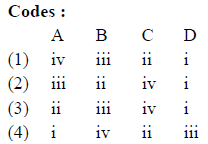
9. The settlement developed along the riverside or along the railway track tend to develop :
(1) Nuclear pattern
(2) Linear pattern
(3) Dispersed pattern
(4) Star shaped pattern
10. Which among the following is not considered in case of Central Place (CP) ?
(1) CP retails goods and services to surrounding areas.
(2) CP will have threshold to provide services.
(3) CP will have hierarchy in services.
(4) CP will have population of different purchase power.
11. A country currently has a population of 50 million and an annual growth rate 2.5 percent. If growth rate remain constant, how many years it will take to double its population ?
(1) 25 years
(2) 28 years
(3) 31 years
(4) 35 years
12. Which among the following indicator is not used for the construction of the Human Development Index ?
(1) Expectation of life at birth
(2) Adult literacy rate
(3) G.D.P. per capita (PPP Per capita US $)
(4) Percentage of population below poverty line
13. Which among the following indicator is not used for estimation of Human Development Index (HDI) ?
(1) Contraceptive prevalence Rate
(2) A long and healthy life
(3) Access to knowledge
(4) A decent standard of living
14. Which among the following type is SRS life table ?
(1) Complete
(2) Cohort
(3) Period
(4) Actuarial
15. Which among the following is not the correct approach of the ‘Reproductive, maternal, newborn, child and adolescent’ (RMNC+A) programme under the National Rural Health Mission (NRHM) ?
(1) Continuum of Care
(2) National Iron + Initiative
(3) Comprehensive screening and early intervention for defects at birth
(4) Partnership with Panchayati Raj Institutions
16. According to NFHS-3 which of the following is current use of spacing methods in India :
(1) 5%
(2) 10%
(3) 12%
(4) 15%
17. Which one of the following statements is true for demographic transition stage-I ?
(1) High birth rates, high death rates, and low growth rates.
(2) High birth rates, declining death rates, and rising growth rates.
(3) Continued decline of death rates, declining birth rates, growth rate decline from high to lower levels.
(4) Low birth rates, low death rates and low growth rates.
18. According to the SRS Bulletin September 2014, the natural growth rate of India is,
(1) 10.4%
(2) 12.4%
(3) 14.4%
(4) 16.4%
19. Match names of the scholars given in List – I with the contribution made by them in the area of Demography/Population studies given in List – II below :

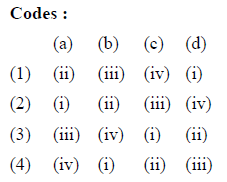
20. The population Data Committee was set-up by the Government of India in which among the following years ?
(1) 1940
(2) 1944
(3) 1948
(4) 1952
21. The quality of data can be ascertained from the value of the Whipple’s index. Match index value in List – I with data quality in List – II and select the correct answer using codes given below :


22. Which of the following data are required to compute a life table ?
(a) Age specific death rates
(b) Age distribution of population
(c) Number of deaths
(d) Number of deaths in different ages
Codes :
(1) (a) and (b)
(2) (b) and (c)
(3) (d) only
(4) (a) only
23. Census Commissioner of India has specified a few criteria to define an urban area. Which is the correct number of such criteria ?
(1) 1
(2) 2
(3) 3
(4) 4
24. Assertion (A) : Lower temperatures are more detrimental to older populations.
Reason (R) : Temperatures below 20 to 15 °C cause deaths due to cardiovascular diseases and malaria among older populations.
Codes :
(1) Both (A) and (R) are true and (R) is the correct explanation of (A).
(2) Both (A) and (R) are true, but (R) is not the correct explanation of (A).
(3) (A) is true, but (R) is false.
(4) (A) is false, but (R) is true.
25. Which of the following method is used by the Expert Committee for population projection in India ?
(1) Geometric method
(2) Exponential method
(3) Component method
(4) Logistic method
26. How many number of categories of diseases have been classified under International Classification of Diseases (ICD) 10th Revision ?
(1) 19
(2) 20
(3) 21
(4) 22
27. What are the different criteria for the evaluation of family planning ?
(a) Goal effectiveness
(b) Realized efficiency
(c) Potency effectiveness
(d) Capacity effectiveness
Codes :
(1) (a), (b)
(2) (a), (b), (c), (d)
(3) (a), (b), (c)
(4) (a), (c)
28. According to SRS (2010-13) cause of deaths statistics, top ten causes of deaths accounts for almost
(1) 70% of all deaths
(2) 80% of all deaths
(3) 90% of all deaths
(4) 100% of all deaths
29. Assertion (A) : Population projection by component method gives better estimates.
Reason (R) : Component method of projection includes both age and sex composition of population.
Codes :
(1) Both (A) and (R) are true and (R) is the correct explanation of (A).
(2) Both (A) and (R) are true, but (R) is not the correct explanation of (A).
(3) (A) is true, but (R) is false.
(4) (A) is false, but (R) is true.
30. According to NFHS-3, Which of the following range represents Contraceptive Prevalence Rate (CPR) by modern methods for India ?
(1) 35% – 40%
(2) 40% – 45%
(3) 45% – 50%
(4) 50% – 55%
31. Which one of the following will be affected according to Coale (1986) if a country achieve below replacement level of fertility ?
(1) Demographic effects
(2) Social effects
(3) Political effects
(4) All the above
32. The total unmet need for family planning in India according to NFHS-III is
(1) Less than 5%
(2) 5 to upto 8%
(3) 8 to upto 10%
(4) More than 10%
33. Assertion (A) : Some of the studies have shown that low skilled immigrants actually raised the wages of their less-educated native born counterparts in the surrounding area.
Reason (R) : The native born less educated persons shifted from manual labour to office jobs, which paid them higher wages.
Codes :
(1) Both (A) and (R) are true and (R) is the correct explanation of (A).
(2) Both (A) and (R) are true but (R) is not the correct explanation of (A).
(3) (A) is true, but (R) is false.
(4) (A) is false, but (R) is true.
34. Match items of List – I with items of List – II given below :


35. Assertion (A) : Indian towns and cities have high air pollution levels.
Reason (R) : High air pollution levels are due to high presence of automobiles and high density of population.
Codes :
(1) Both (A) and (R) are true and (R) is the correct explanation of (A).
(2) Both (A) and (R) are true, but (R) is not the correct explanation of (A).
(3) (A) is true, but (R) is false.
(4) (A) is false, but (R) is true.
36. Arrange the following states, high to low, by their child sex ratio (age 0 – 6) according to the 2011 Census data :
(a) Bihar
(b) MP
(c) Rajasthan
(d) UP
Codes :
(1) Bihar, Rajasthan, MP, UP
(2) UP, Bihar, MP, Rajasthan
(3) Bihar, MP, UP, Rajasthan
(4) MP, Bihar, Rajasthan, UP
37. Which one of the following is the top most (Rank-I) cause of deaths in India according to SRS cause of deaths report in India 2010-13 ?
(1) Tuberculosis
(2) Respiratory diseases
(3) Diarrhoeal diseases
(4) Cardiovascular diseases
38. Who among the following was the founder of Family Planning Association of India ?
(1) M.S. Swaminathan
(2) Rajkumari Amrit Kaur
(3) J.R.D. Tata
(4) S. Chandrasekhar
39. Match the type of indicators given in Column-I with examples given in Column-II.


40. Match the following in the area of internal migration estimation in List – I to List – II and select the correct answer using codes :

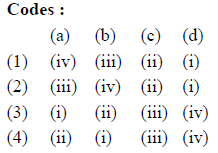
41. Arrange the following states, high to low, by their level of Institutional deliveries (DLJ S-3) :
(a) Bihar
(b) MP
(c) Rajasthan
(d) UP
Codes :
(1) Rajasthan, MP, Bihar, UP
(2) Rajasthan, MP, UP, Bihar,
(3) MP, Rajasthan, Bihar, UP,
(4) MP, Rajasthan, UP, Bihar,
42. According to DLHS-III Report, what percentage of pregnant women in India had taken three or more ante-natal check-ups ?
(1) Less than 35%
(2) 35% to upto 45%
(3) 45% to upto 55%
(4) More than 55%
43. Which amongst the following is not correct regarding ‘Mission Indradhanush’ ?
(1) To ensure full immunization for children (upto two years) and pregnant women.
(2) To strengthen cold chain equipments in the EAG states.
(3) It is implemented in 201 high focus districts.
(4) Special immunization drives to improve the routine coverage in the country.
44. Who among the following propounded ‘Epidemiologic Transition’ theory ?
(1) Abdel R. Omran
(2) Ester Boserup
(3) Philip K. Hooper
(4) Warren Thompson
45. Match names of Scientists in List – I with the years in List – II for construction of life table and select the correct answer using codes given below :
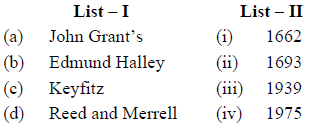
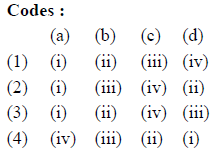
46. Which one of the following is not a goal set in National Population Policy 2000 ?
(1) Achieve universal access to treatment for HIV/AIDS.
(2) Achieve 80% institutional delivery.
(3) Reduce IMR to below 30 per 1000 live births.
(4) Achieve 100% registration of births, deaths and marriage.
47. Find the correct order of industrial food system from the following that contribute to the industrial crisis :
(1) Farming ; deforestation ; transport ; processing and packaging of food
(2) Deforestation, farming, transport ; processing & packaging of food
(3) Transport ; farming ; deforestation ; processing & packaging food
(4) Processing & packaging of food ; transport ; deforestation ; farming
48. The most widely used method of population projection for urban rural areas and developed by the United Nations is known as
(1) Urban – Rural growth difference method
(2) Component method
(3) Urban Growth method
(4) Rural Growth method
49. What is physiological density ?
(1) The overall population per sq.km. area of productive farming land
(2) The overall agrarian population per sq.km. area of productive farming land
(3) The overall number of inhabitants per sq.km land area
(4) Population inhabiting a metropolitan region, sq.km area of housing space
50. Who among the following said ‘Development can be achieved by transferring labour from subsistence sector to modern sector ?
(1) Arthur Lewis
(2) Liebenstein
(3) Harrod-Domar
(4) Ricardo
51. Match the items in List – I with items in List – II given below and select the correct code using codes given below :

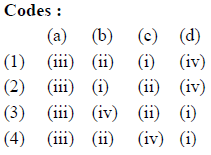
52. Which of the following assumptions are essential for the estimation of fertility by ‘own children method’ ?
(a) Children ages are reasonably accurate.
(b) Most of the children live with their mothers.
(c) The relationship of each child to the head of the household is well defined.
(d) Mortality levels are relatively low during the estimation period prior to enumeration.
Codes :
(1) (a), (b), (c)
(2) (b), (c), (d)
(3) (a), (b), (c), (d)
(4) (a), (b), (d)
53. In which year United Nations Development Fund (UNDF) was renamed as United Nations Fund for Population Activities (UNFPA) ?
(1) 1969
(2) 1968
(3) 1967
(4) 1966
54. Which among the following is an indirect anti-natalist policy ?
(1) Providing information about breast feeding
(2) Raising age at marriage
(3) Educating parents
(4) Provision of contraceptive services
55. Which one of the following mortality rates strongly affects the expectation of life at birth ?
(1) Crude death rate
(2) Infant mortality rate
(3) Age specific death rate
(4) Maternal mortality rate
56. Which amongst the following diseases covered under immunization of children ?
(a) Kwashiorkor
(b) Diphtheria
(c) Pertusis
(d) Tetanus
Codes :
(1) (a), (b), (c)
(2) (a), (d), (b)
(3) (d) (a), (c)
(4) (b), (c), (d)
57. Calculate the expectation of life at age 5 with the values of Tx = 64,00,000 and lx = 95,000.
(1) 68.34
(2) 69.45
(3) 67.37
(4) 66.56
58. According to economist Leibenstein, there are economic advantages having children.
Select the correct combinations from the following :
(a) Consumption utility
(b) Work income utility
(c) Old age security utility
(d) Contribution to extended family utility
Codes :
(1) (a) only
(2) (a) and (c) only
(3) (a), (b) and (c)
(4) (a), (b), (c) and (d)
59. Which among the following source cannot provide information on internal migration ?
(1) Census
(2) Surveys
(3) Registration of vital events
(4) Population Registers
60. Which one of the following combination of disease strategies are implemented by the Ministry of Health and Family Welfare, Government of India ?
(1) Malaria and Dengue
(2) TB and HIV
(3) Cancer and Cardiovascular disease
(4) STD and HIV
61. According to Census of India 2011 information which among the following states has the highest proportion of slum households to urban households ?
(1) Chattisgarh
(2) West Bengal
(3) Andhra Pradesh
(4) Odisha
62. Which one of the statement is not true for demographic dividend ?
(1) Boosts per capita income
(2) Potential population of working age increase
(3) Transition to low fertility
(4) Lower mortality produce longer lives.
63. Match the items in List – I with List – II and select the correct answer using the codes given below :


64. Malaria is which of the following type of disease ?
(1) Water borne disease
(2) Air borne disease
(3) Polen borne disease
(4) Vector borne disease
65. Which among the following states has recorded highest number of new towns in 2011 Census ?
(1) Gujarat
(2) West Bengal
(3) Maharashtra
(4) Tamil Nadu
66. Arrange the following states, high to low, by their coverage of pregnant women with three or more ante-natal check up (NFHS-3) :
(a) Kerala
(b) Tamil Nadu
(c) Karnataka
(d) Andhra Pradesh
Codes :
(1) Kerala, Tamil Nadu, Karnataka, Andhra Pradesh
(2) Tamil Nadu, Kerala, Andhra Pradesh, Karnataka
(3) Tamil Nadu, Kerala, Karnataka, Andhra Pradesh
(4) Kerala, Tamil Nadu, Andhra Pradesh, Karnataka
67. The migration tables provided by Census of India does not give information on :
(1) Migration by gender
(2) Migration by age
(3) Remittances send by migrants
(4) Interstate migration
68. The sex structure of any population is determined by the past trends of
(1) Sex ratio at birth
(2) Sex differential in mortality
(3) Sex differential in migration
(4) All the above
69. Match the following items in List – I with items in List – II.

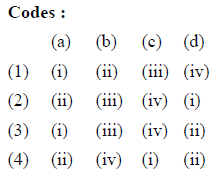
70. What is the proportion of poor according to 68th Round of NSSO (2011-12) in India ?
(1) 20.9%
(2) 21.9%
(3) 22.9%
(4) 25.9%
71. Which among the following statements is not correct according to Esther Boserup ?
(1) In those times of pressure, people will find out ways to increase the production of food by increasing work force, machinery, fertilizers etc.
(2) Slash and burn methods followed to clear fields to restore soil fertility.
(3) Food is not sufficient for everyone, the extra people have to die.
(4) Size and growth of population depend on food supply and agricultural methods.
72. Currently available population projections made by the Expert Committee on population projections cover the projections for which of the following period ?
(1) 2001-2026
(2) 2006-2026
(3) 2006-2031
(4) 2011-2036
73. According to NFHS-3, which of the following major State of India (population > 20 million) has reported highest prevalence of spacing methods ?
(1) Haryana
(2) Punjab
(3) UP
(4) West Bengal
74. Given the following data for the year 2015 and assuming no migration, which expression can be used to compute mid-2015 population ?
Data :
P = Population in the beginning of year 2015
D = Deaths in the year 2015
B = Births in the year 2015
Codes :
(1) 2P + B – D
(2) ![]()
(3) 
(4) 
75. Arrange the following landmarks in India’s family welfare program sequentially, from early to later years and select correct code using given below codes :
(a) Population policy
(b) Universal Immunization Programme
(c) Child Survival and Safe Motherhood (CSSM) Programme
(d) Target free approach
Codes :
(1) (b), (c), (d), (a)
(2) (a), (b), (c), (d)
(3) (c), (b), (d), (a)
(4) (b), (d), (c), (a)
Latest Govt Job & Exam Updates: